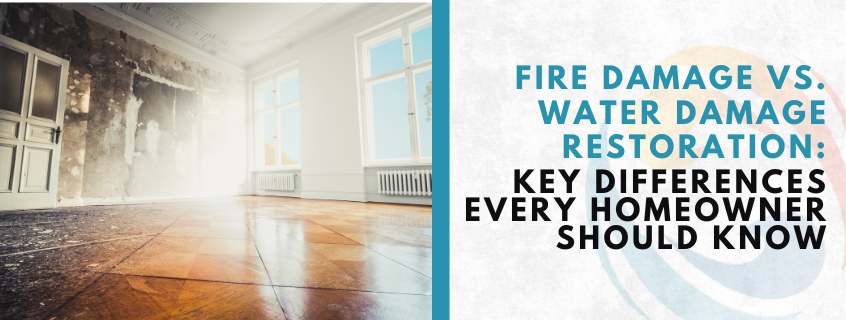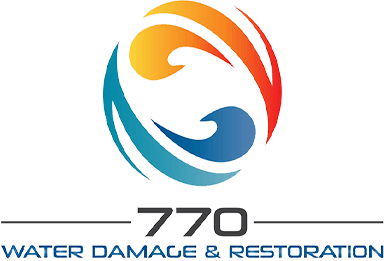
Imagine waking up one day to the smell of smoke or the sound of rushing water. It’s a nightmare scenario for any homeowner. Whether caused by a raging fire or a burst pipe, damage to your home can be devastating. Both situations are scary, stressful, and costly. But while they may seem similar at first glance, there are many differences between fire damage vs water damage restoration that every homeowner should know.
Understanding these differences can help you act faster, make smarter decisions, and protect your home better. Let’s dive into what sets these two types of damage apart, how the restoration process works for each, and what steps you can take to protect your home.
When disaster strikes, homeowners often find themselves asking a crucial question: what’s the difference between fire damage vs water damage restoration? While both involve restoring homes after a crisis, the processes, tools, and challenges are quite distinct. Fire damage often leaves behind charred walls, weakened structures, and pervasive smoke odors that penetrate deep into surfaces. In contrast, water damage quietly seeps into floors and walls, creating a breeding ground for mold and causing warping, swelling, and hidden rot. Understanding these differences is key to managing your response effectively.
In the world of fire damage vs water damage restoration, timing is everything. Fire damage spreads fast, but water damage can be equally destructive over time if not addressed quickly. Fire restoration requires specialized tools like HEPA vacuums and ozone generators, while water damage calls for high-powered extractors, moisture meters, and industrial dehumidifiers. Homeowners need to know that each type of restoration comes with its own set of health risks and cost considerations, which can greatly affect the recovery timeline and budget.
Ultimately, fire damage vs water damage restoration is about more than just fixing visible damage. It’s about creating a safe, livable space once again, free from hidden dangers like mold spores or residual smoke toxins. Knowing what to expect and calling in the right professionals at the right time can make all the difference between a stressful, prolonged recovery and a smooth return to normal life.
Real-Life Stories: How Fire and Water Damage Unfold
One sunny morning, a homeowner in Tarzana came back from work to find their living room flooded due to a broken washing machine hose. The wooden floor was warped, and mold had started forming within just two days. They called a trusted local team for water damage cleanup, and slowly, things returned to normal.
But another neighbor in Hermosa Beach recently faced an even more daunting challenge. A small kitchen fire escalated into a full-blown house fire, leaving behind soot, smoke, and structural damage. They called for Fire Damage Restoration Hermosa Beach services, which proved crucial in salvaging parts of the home and personal belongings.
These two scenarios highlight how fire damage vs water damage restoration present unique challenges and require different approaches.
The Nature of the Damage
While both fire and water can wreak havoc on a home, the kind of damage they leave behind is very different.
Fire Damage:
- Burns through wood, drywall, plastic, and other materials.
- Leaves behind soot and smoke stains that penetrate deep into surfaces.
- Produces odors that linger long after the flames are extinguished.
- Weakens the structural integrity of the building.
- Can shatter windows and melt metal components.
Water Damage:
- Soaks walls, floors, and furniture, leading to warping and deterioration.
- Encourages mold and mildew growth if not addressed quickly.
- Damages electrical systems and compromises insulation.
- Leaves musty odors and water stains.
- Spreads gradually, making it harder to detect at first.
When comparing fire damage vs water damage restoration, the key lies in recognizing the specific damage caused by each disaster and tailoring the response accordingly.
When comparing fire damage vs water damage restoration, homeowners need to understand the unique challenges each type of disaster brings. Fire damage vs water damage restoration is not just about cleaning; it involves specific techniques and equipment tailored to each scenario. While fire damage vs water damage restoration both require swift action, fire restoration often demands specialized tools like thermal foggers and ozone machines, while water damage cleanup calls for moisture meters and dehumidifiers. Homeowners who recognize the importance of fire damage vs water damage restoration are better equipped to protect their property and health in the face of an emergency.
How the Damage Spreads
Time is a crucial factor in both types of damage. Fire damage spreads rapidly, consuming large areas in minutes, while water damage creeps in slowly, often going unnoticed until it’s too late.
Fire Damage:
- Flames move quickly through flammable materials.
- Smoke and soot travel through vents, reaching far from the fire source.
- Heat can cause damage to structural elements even in rooms not directly affected by the flames.
Water Damage:
- Water seeps into cracks, behind walls, and under floors.
- Moisture spreads through porous materials like wood and drywall.
- If left unchecked, mold growth can begin within 24–48 hours.
Professionals handling fire damage vs water damage restoration must identify not just visible damage but also hidden trouble spots.
Health Risks: Invisible but Serious
Both fire and water damage can pose serious health risks if not handled properly.
The complexities of fire damage vs water damage restoration go beyond surface cleanup. Fires can leave behind toxic residues and structural damage that require expert handling, while water damage often leads to hidden mold and compromised electrical systems. Homeowners facing fire damage vs water damage restoration should also be aware of the time-sensitive nature of both, as delays can make the damage far worse. Effective fire damage vs water damage restoration involves a careful balance of safety protocols, advanced technology, and skilled professionals. By understanding the key differences in fire damage vs water damage restoration, property owners can make faster, smarter decisions during emergencies.
Fire Damage Risks:
- Inhalation of smoke and soot can irritate lungs and worsen respiratory conditions.
- Chemicals released during combustion, such as carbon monoxide and benzene, are toxic.
- Residual firefighting chemicals can linger on surfaces and in the air.
Water Damage Risks:
- Mold is a significant hazard, with species like Aspergillus and Stachybotrys (black mold) causing respiratory issues.
- Floodwaters often carry bacteria, viruses, and chemical contaminants.
- Damp environments attract pests like termites and rodents.
This is where calling in experts like Fire Damage Restoration Hermosa Beach or water cleanup teams can prevent long-term health issues.
The Cleanup Process: Step by Step
| Restoration Step | Fire Damage | Water Damage |
| Inspection | Check fire origin, smoke path, and structural integrity | Identify water source, assess flow and spread |
| Safety | Remove hazards like gas leaks, compromised beams | Shut off water, assess electrical hazards |
| Cleanup | Remove soot, debris, and damaged materials | Extract water, dry surfaces, sanitize area |
| Deodorizing | Use air scrubbers, ozone generators | Use dehumidifiers, antimicrobial treatments |
| Restoration | Rebuild or replace structural elements | Repair or replace water-damaged components |
In fire damage vs water damage restoration, the choice of tools and methods depends entirely on the type of damage encountered.
Specialized Equipment and Techniques
Fire Damage Restoration Tools:
- HEPA vacuums are used to remove fine soot particles.
- Thermal foggers and ozone generators to neutralize smoke odors.
- Air scrubbers improve indoor air quality.
- Protective gear to safeguard workers from toxins.
Water Damage Restoration Tools:
- Water extractors and wet vacs for initial water removal.
- Moisture meters and thermal cameras to detect hidden moisture pockets.
- Industrial dehumidifiers and air movers to accelerate drying.
- Antimicrobial treatments to inhibit mold growth.
These tools play a pivotal role in effective fire damage vs water damage restoration.
Costs and Insurance Considerations
Dealing with damage is costly, but being informed helps you prepare.
Fire Damage Costs:
- Often higher due to structural repairs and specialized cleaning.
- Insurance usually covers fire damage, but policies vary.
- Cleaning electronics, fabrics, and removing odors adds to costs.
Water Damage Costs:
- Lower if the problem is caught early.
- Insurance may not cover flood damage or long-term leaks.
- Mold remediation can significantly increase expenses.
Understanding the costs and ensuring you have adequate coverage is crucial when comparing fire damage vs water damage restoration.
Recovery Timelines: When Will Life Feel Normal Again?
| Stage | Fire Damage Timeline | Water Damage Timeline |
| Inspection & Safety | 1–2 days | 1–2 days |
| Cleanup | 3–7 days | 1–2 days |
| Deodorizing & Drying | 1–2 weeks | 3–7 days |
| Repairs & Rebuild | 2–8 weeks or longer | 1–4 weeks |
These timelines are rough estimates. In both cases, calling restoration experts early can save time and money.
Lingering Smells and Stains
After restoration, homeowners often worry about residual odors and stains.
- Fire Damage leaves behind smoky smells and dark soot marks.
- Water Damage causes musty odors, peeling paint, and stubborn water stains.
Professional-grade air purifiers, cleaning agents, and deodorization techniques are essential to fully restore comfort after fire damage vs water damage restoration.
Preventative Measures for the Future
Prevent Fire Damage:
- Test smoke alarms monthly.
- Maintain electrical systems.
- Avoid unattended cooking or candles.
- Store flammable items safely.
Prevent Water Damage:
- Inspect pipes and hoses for leaks.
- Clean gutters and downspouts regularly.
- Install a sump pump in flood-prone areas.
- Learn the location of your main water shut-off valve.
When to Call the Professionals
Some warning signs you shouldn’t ignore:
- Persistent smoky or musty odors.
- Warped floors, sagging ceilings, or peeling paint.
- Visible mold growth on walls or ceilings.
- Soot deposits are found in areas far from the fire.
Professionals specializing in fire damage vs water damage restoration have the expertise and tools to handle these issues safely and effectively.
Final Thoughts
Disasters don’t knock before entering. Whether it’s a sudden flood or a house fire, knowing the differences in fire damage vs water damage restoration can make all the difference. Fires leave behind a trail of soot, smoke, and structural damage. Water sneaks in quietly, bringing mold and rot. Both types of damage are serious and require fast, informed action.
Remember, restoration isn’t just about fixing what’s broken. It’s about restoring safety, comfort, and peace of mind. Whether you’re facing charred walls or waterlogged floors, trusted experts—including Fire Damage Restoration Hermosa Beach—are ready to help you rebuild.
Understanding the nuances of fire damage vs water damage restoration is crucial for any homeowner who wants to protect their property from lasting harm. While fire and water damage might seem like two sides of the same coin, the processes required to restore a home after these disasters are quite different and uniquely challenging. Fire damage often leaves behind a scorched and hazardous environment. The intense heat from a fire can weaken the integrity of walls, ceilings, and support beams, making the structure unsafe to inhabit.
Smoke and soot, both byproducts of fire, permeate every surface, from walls to furniture, embedding odors and potentially harmful chemicals into the home. In addition, firefighting efforts may introduce significant water damage, compounding the problem and creating the need for a dual restoration approach. Conversely, water damage creeps in silently, saturating everything in its path. A burst pipe or heavy rainfall can cause water to seep into floors, walls, and even the foundation. Over time, this moisture creates the perfect breeding ground for mold, mildew, and rot, all of which can compromise the health of residents and the stability of the home.
The distinction between fire damage vs water damage restoration lies not only in the type of damage but also in the techniques and tools required to fix it. Fire restoration professionals use specialized equipment such as HEPA vacuums to remove fine soot particles, thermal foggers and ozone generators to neutralize persistent smoke odors, and air scrubbers to improve air quality. Protective gear is essential to safeguard workers from inhaling toxins and hazardous residues. In contrast, water damage restoration involves the use of high-powered water extractors, moisture meters to detect hidden pockets of water, industrial-grade dehumidifiers, and air movers to expedite drying.
Antimicrobial treatments are also applied to prevent mold growth and ensure a safe environment. The timing of these restoration efforts is critical. Delays in responding to either fire or water damage can exacerbate the issues, leading to more extensive repairs and higher costs. Homeowners should recognize that while both types of damage require prompt action, the expertise and methods needed for fire damage vs water damage restoration are not interchangeable.
Moreover, the health risks associated with each type of damage differ significantly. Fire damage can expose residents to lingering toxic fumes, fine soot particles that aggravate respiratory conditions, and potentially dangerous structural weaknesses. Water damage, on the other hand, often brings a surge of mold spores, bacteria, and even pests if not addressed quickly. Homeowners must also navigate complex insurance claims processes for both fire and water damage. Fire insurance typically covers fire damage, but the extent of coverage can vary depending on the policy.
Water damage insurance, especially for flood-related incidents, is often more limited and may exclude damage from slow leaks or maintenance issues. As a result, understanding fire damage vs water damage restoration is not just about cleanup—it’s about being proactive, knowledgeable, and prepared for the unexpected. By appreciating the distinct challenges of each type of restoration and calling on professionals when needed, homeowners can safeguard their property and loved ones from the lasting impacts of disaster.
FAQs: Everything You Need to Know About Fire and Water Damage Restoration
1. What is the difference between fire damage and water damage restoration?
Fire damage restoration focuses on repairing and restoring areas affected by flames, smoke, and soot. This process includes removing charred materials, cleaning smoke residues, and eliminating odors. Water damage restoration, on the other hand, deals with issues caused by flooding, leaks, or moisture intrusion. It involves extracting water, drying affected areas, and preventing mold growth. Both processes require specialized techniques and equipment to ensure the property is safely and effectively restored.
2. How quickly should I respond to fire or water damage in my home?
Immediate response is crucial for both fire and water damage. Delays can lead to further structural issues and health hazards. 770 Water Damage & Restoration offers 24/7 emergency services, ensuring rapid response to mitigate damage and begin the restoration process promptly.
3. Does homeowners’ insurance cover fire and water damage restoration?
Coverage varies depending on your insurance policy. Typically, sudden and accidental damages, like those from a fire or a burst pipe, are covered. However, damages resulting from neglect or lack of maintenance may not be. 770 Water Damage & Restoration works directly with insurance providers to assist homeowners in navigating claims and ensuring they receive the benefits they’re entitled to.
4. What steps are involved in the fire damage restoration process?
The fire damage restoration process includes:
Assessment: Evaluating the extent of the damage.
Board-Up and Tarping: Securing the property to prevent further damage.
Water Removal and Drying: Eliminating the water used to extinguish the fire.
Smoke and Soot Removal: Cleaning surfaces affected by smoke and soot.
Cleaning and Sanitizing: Disinfecting areas to ensure safety.
Restoration: Repairing or replacing damaged structures and materials.
770 Water Damage & Restoration employs certified professionals to handle each step efficiently, ensuring your home is restored to its pre-fire condition.
5. How do professionals handle water damage restoration?
Water damage restoration involves:
Inspection and Assessment: Determining the extent of water intrusion.
Water Removal: Using pumps and vacuums to extract standing water.
Drying and Dehumidification: Employing air movers and dehumidifiers to dry affected areas.
Cleaning and Sanitizing: Disinfecting surfaces to prevent mold and bacterial growth.
Restoration: Repairing or replacing damaged materials.
770 Water Damage & Restoration utilizes advanced equipment and techniques to ensure thorough and effective water damage restoration.


